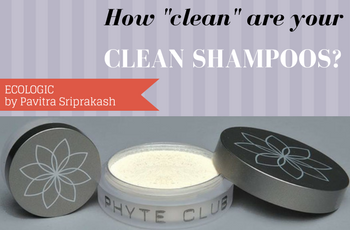25 Mar 2017, New Indian Express: ECOLOGIC- Pavitra Sriprakash, the Chief Designer and Director of Shilpa Architects writes about going clean & organic beauty products.
PDF | LINK to the New Indian Express Site
Last weeks column was about the O-list of Organic products worth the extra bucks spent in monthly grocery budgets. This week the focus is on another channel that feeds more poison into our bodies than we are aware. Chemicals mindlessly dabbed and sprayed to enhance self-esteem, look good or be attractive enter our bodies through our eyes, mouths, skin and scalp. Those love potions in classy containers on shower ledges and counter tops actually contain the most vile toxins that cause villainous debilitation, even painful death.
“Clean Beauty,” is a recent movement that addresses the beauty industry in much the same way as the labels “Organic” and “Natural” do for food. The trend towards Clean Beauty is analogous to the movement favouring fresh and toxin free edibles. However there are some important differences that discerning consumers should know, and be clear about when or whether they should go clean. Just as it is important to be circumspect with apples and potatoes but be lenient with pineapples or cabbage; so too should there be awareness about the critical list of detoxing beauty products and treatment routines.
Most of us cannot be without antiperspirants and deodorants in hot and humid places. Antiperspirants contain an “aluminum-based compound” which is recognised as a major carcinogen. Several studies link it to breast cancer. Most toxins in these cheap products can go unlisted or remain hidden as “fragrance”. Our underarms are the most critical detoxifying areas of our anatomies loaded with lymph nodes and sweat glands. They come in direct contact with synthetic compounds where skin is perhaps more vulnerably absorbent than anywhere else. People in many South East Asian countries have used natural alum as a deodorant for centuries. Ayurveda too considers natural alum as “crystal deos” and have included them to formulate nature-based deodorants through the ages. Will it not be effectively prudent to make the change to naturals here?
A large percentage of lip colours and balms get into our stomachs. Conventional lip enhancers are made primarily of petroleum jelly, with toxic fragrances, flavors, and texturizers. When going clean, look out for nourishing elements like shea butter, olive oil or even shuddh desi ghee! It seems a no-brainer to switch and be saved from consuming dyes that are not even permitted in food!
Beauty products for hair are perhaps the industry’s most toxic. Powerful fragrances and sulfates, endocrine disrupting preservatives, carcinogenic plasticisers and dyes are common ingredients. Head massages drive them ultimately into digestive tracts, and coupled with direct inhalation as vapours during hot showers make such beauty products for hair deadly. “Clean” shampoos will not contain sulfates and parabens; similarly “clean” conditioners rely on natural oils and butters as opposed to silicones and plasticisers.
The average consumer is by no means a chemist and cannot understand most ingredient lists with mysterious chemical acronyms of dubious relevance and safety. Be wary of the word ‘fragrances’ as these are usually unconvincing and deliberately confusing. As a conscious consumer look for products that completely disclose their constituents. When it comes to “clean beauty” remember products must have labels and importantly, shorter their ingredients list, safer and better are they for sustainable and beautiful health.



